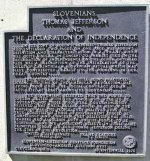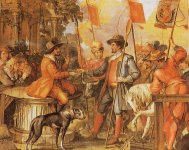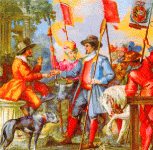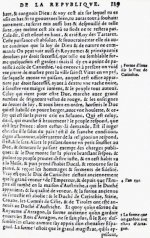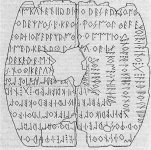"created only in the year 998AD from bavarian origins"
Sure, like Karantania never existed...
Austria was built on the Bavarian & Karantanian law called
Rota (in latin as "
Institutio Sklavenica Lex"). This democratic law - which was talking about the will of people(women have had equal rights as men), later influenced American president, Thomas Jefferson in his Declaration of Independence, who read about old Karantania over Jean Bodin and his "
Lex Six Livres de la Republique" (1576)
http://www2.arnes.si/~gljsentvid10/oseb_stran/bodanis_karantanija01.jpg
View attachment 6458
The country of Karantania was separated between Frankish and Bavarian rule, or better said annexed to the Frankish supremacy from the beginning, as was partially also Bavaria. Karantanian leadership was forced into a strategic "partnership" (instead of their constant wars which were rather religious Christian vs "pagan" campaigns ) because of the invasion of Avars / Obri / Hobri (Hebrew Turks from Khazar Khanate) which included an aid in military on the Karantanian borders. In return for that help in year 743 "AD", Karantanians were forced into an obligation to accept the Christian religion, which consequently meant that they were automatically obligated to follow the Frankish orders; or the "Holy" roman (Frankish) empire"...
You have to realize that the territory of current Austria, especially the eastern and central part was generally populated with the Slavic speaking people at that time. How ever, they carried their Carinthian (Karantanian) tradition of Inauguration of their dukes - in Slovene language (The last instalation of Karantanian (Carynthian; Koroški) dukes happened exactly 600 years ago (year 1414) with Ernest Železni (Ernest, duke of Austria) in traditional Slovene language at the Zollfeld plain (
Gosposvetsko polje), which proves that the country was never "germanized" to the final level even at that time... There are linguistic, cultura, genetic elements which prove, that Austria was never fully "Bavarian" and nobody can hide this.
View attachment 6457
Karantania is Carantania
The name of the region, like neighbouring Carantania and Carinthia, probably derives from the Carni, a Celtic tribe who had lived for centuries in the fertile plains between the Rhine and the Danube rivers where other Celtic peoples lived. Starting from 400 BC, the demographic growth and the pressure of the Germanic peoples, originated a migratory flood towards the south. The Carni crossed the Alps via the Plöcken Pass and settled in the region which is nowadays named Carnia and in the piedmont zone of Friuli. They practiced hunting and breeding. During the hard winters the herders used to move with their cattle down to the piedmont plains. Also they were skilful iron and wood manufacturers. The Carni were headed by a king and a sacerdotal caste of druids.
Antiquity
The first historical date related to the arrival of the Carni is 186 BC, when some 50,000 Carni, composed of armed men, women and children descended towards the plains (in which they previously used to winter) and on a hill they founded a stable defensive settlement, Akileja. The Romans, concerned by the expansion of this people, in 183 BC forced back the Carni to the mountains, they destroyed their settlement and they founded a defensive settlement at the north-east boundaries. The new settlement was named Aquileia, after the former Celtic name Akileja. The triumvirs that founded that settlement were Publius Scipio Nasica, Caius Flaminius and Lucius Manlius Acidinus.
The area is named after the Carni tribe
http://en.wikipedia.org/wiki/Carni
The Carni in Italy became the modern Friuliani
The Carni came down from the alps and split the venetic people , basically in half .......are they Gaulish or celtic people.............still debatable. But the Friulian language has base words which is ancient gaulish according to linguistic scholars
Since the veneti saved the Romans and Rome with a push against the gauls in lombardy, the Romans sent men to save the veneti from the carni........Aquiliania was the stronghold to control the carni
Ancient friuli culture is
http://en.wikipedia.org/wiki/Castellieri_culture
while veneti culture is
http://en.wikipedia.org/wiki/Este_culture
Castellieri culture was also Liburni ( illyrian ) area .................and also typical of mycenean burial styles
@vedun
maybe you can decifer the friulian below................the venetian is 95% like the venetian in central veneto
Central (Udine) Friulian
Copiis
Il puar biāt al ą copiāt il Siōr
par dīj: “O soi come tč”:
ma il Siōr nol ą copiāt.
Magari chel biāt j ą vuadagnāt,
ma i fīs, daspņ, cetant ąno pajāt
no savint jéssi sé?
Il lōr destin al č, savéso quāl?
Copie de brute copie origjnāl!
Eastern/Coastal (Triestino) Venetian
Copie
Il sempio il gą copią il Sior
par dir “Mi son come ti”
ma il Sior no’l gą copią.
Forsi quel sempio xč divegnudo sior,
ma i fioi, dopo, quanto i gą pagą par
non saver come xe stado?
Savč vł qual xč il loro destin?
Only changes needed to central veneto is
gą = gha
xč = xe
Savč = saver
vł = el ...............the friulian/venetian L is what is referred to as the vanishing L
It's phonetic characteristic is the vanishing L that can be described as a "lazy" L, its not sounded, which is why the word is sometimes missing the L
I translated the venetian below into....
The simpleton has copied the master
to say "I am like you"
but the master has not copied ( anyone)
Maybe the simpleton became the master
but his sons, later, had paid for
not knowing how it came to be (about)?
How do they know what is their destiny?


